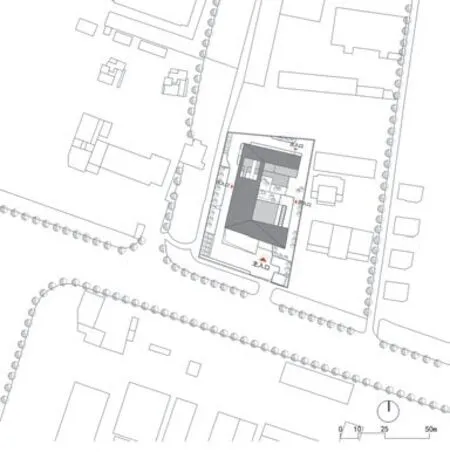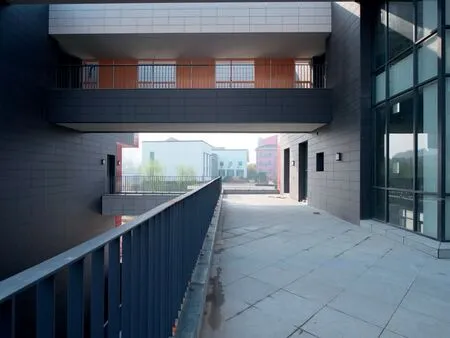李守才均陶艺术馆,宜兴,中国
2021-10-27王建国,朱渊,姚昕悦等
“均陶”是宜兴陶瓷的“五朵金花”之一,李守才是均陶堆花制作的代表性人物,本项目作为李大师日常工作和作品展示场地使用,旨在创造一处具有传统空间意象的现代艺术馆。
艺术馆用地南临通蜀中路,西临河道,东北为其他用地。设计建筑形体为一开口向东的“C”字形————从李大师堆花作品中抽象出的最基本指法,南侧为门厅、展厅等公共空间,北侧为较为私密的窑炉和小型制作工坊。李大师和学徒的作坊布置在西南侧,便利连接南北两区,同时享受南侧采光和西面沿河景观。由于堆花作品的陶缸通常较大、较重,设计还特别考虑设置与建筑空间结合的无障碍运输通道,通过前后开门的电梯实现陶缸在不同标高平面上的运输,创造了作坊区域以陶缸为焦点的趣味空间。
建筑外立面采用米白色陶板幕墙作为基底,体量变化处设置仿木铝合金门窗和红色釉面陶板装饰,用深灰色陶棍做图案化处理。米白色陶板有3种规格,不同肌理形成韵律。陶板幕墙的使用也是对陶都宜兴的回应。□
项目信息/Credits and Data
设计团队/Design Team: 王建国,朱渊,姚昕悦,陆敏,吴昌亮/WANG Jianguo, ZHU Yuan, YAO Xinyue, LU Min,WU Changliang, et al.
建筑面积/Floor Area: 3895 m2
设计时间/Design Period: 2017-2018
竣工时间/Completion Time: 2021
摄影/Photos: 魏羽力,姚昕悦/WEI Yuli, YAO Xinyue

2 西南侧视景/South view(1.2 摄影/Photos: 姚昕悦/YAO Xinyue)
"Jun Earthenware" is one of the "five golden flowers" of Yixing ceramics. LI Shoucai is a representative figure in Jun Earthenware Thumb-Applique technique. This project is built for Mr.LI's daily work and exhibitions, hoping to create a modern art gallery with traditional spatial images.
The site of the art gallery is adjacent to Tongshu Middle Road to the south, the river to the west, and other sites to the north and east. The building has a"C" shape with an opening to the east——an abstraction of the most basic thumb-applique technique of Mr.LI's works. The public spaces such as the foyer and the exhibition halls are arranged on the south side,while the new kiln and private workshops on the north side. Mr. LI and his apprentices' workshops are arranged on the southwest side, which are convenient to connect the north and south areas, while enjoying the south daylighting and the river landscape in the west. Since the earthenware cylinders are usually sizeable and heavy, the barrier-free transportation passageway combined with the building space is specially considered in the design. The earthenware cylinders are transported on different elevations through the elevator with front and rear doors,creating the workshop area a fun space with earthenware cylinders as the focus.
The façade of the building is based on beige ceramic tiles. Faux wood aluminium alloy doors and windows and red glazed ceramic tiles are set at the volume changes, and dark grey ceramic tiles are patterned. There are three kinds of beige ceramic tiles, with different textures forming rhythms. The use of ceramic tiles curtain wall is also a response to the Ceramics City of Yixing.□

3 总平面/Site plan
评论
魏羽力:在通蜀中路上可以看到李守才均陶艺术馆的正立面,贴着米白色陶砖,三层退阶式的浅开口分别对应了主入口、下沉庭院和凹平台,从城市角度强调平面感而抑制了纵深和透视;当转向左侧,西立面同样是三阶式开口的操作,却深达内院,洞口、前后连廊和活动平台,组成了贯穿建筑的空间序列,也和西侧相邻的另一个大师工作室之间建立起一条隐含的东西轴线。主入口的浅空间左右延伸,容纳了展示、接待与休憩的功能,正对着一个两层高的方形展厅,可摆放大型作品(均陶多为陶缸类制品)。上至二层的展廊,其内侧边界因强烈的虚实对比————工作区和展厅的上空和中间的垂直交通体块————而成为驻足之处。在我参观时,建筑尚未投入使用,因而得以忽略空间的既定用途而植入一个旁观者的场景想象。工作区为阶梯式的退台,站在上层可以感受到光线进入室内,穿过周边环绕的浅空间,照亮工作平台。工作平台向上穿过大师的工作区,经连廊到达北翼————一个相对独立的工作起居体块,在不同高度上再次跨越东西轴线,浮现出与周边对话的场景。建筑内化的空间构形中,被围绕的核心空间的用途是确定的,而周围的浅空间则相对模糊,服务与被服务、集中与分散、工作与展示、休息、交流之间的潜在关联也是动态的,这种内向的模糊性应当能够激发使用者与空间在某种程度上的互动和自主使用,形成传统师徒制的“家庭式”氛围。


8.9 剖面/Sections
Comments
WEI Yuli: From Tongshu Middle Road, one can see the façade of Li Shoucai Art Gallery of Jun Earthenware,which is covered with beige ceramic tiles. The threestepped shallow openings respectively lead to the main entrance, the sunken courtyard and the concave platform.It emphasises the sense of plane from an urban angle while inhibiting the depth and perception. When turning to the left, the west façade has also a three-stepped opening, but it reaches as deep as the inner courtyard, the entrance, the front and rear corridors and the platform.While forming a spatial sequence running through the building, it also establishes an implicit east-west axis with the neighbouring master's studio in the west.The shallow space behind the main entrance extends to the left and right, accommodating the functions of exhibition, reception and rest. It faces a square and twostory-high exhibition hall, where large-scale exhibits (Jun Earthenware are mostly jars) can be placed. Up to the exhibition gallery on the second floor, its inner periphery is an area worth stopping owing to the strong virtual contrast between the blocks of vertical transport and the above space of working area and exhibition hall. During my visit, the building had not been put into use, so I was able to ignore the intended use and to imagine the scenes as a spectator. The working area is a stepped settingback platform. Standing on the upper floor, one can feel that there is light entering the room, passing through the shallow space of the periphery, and illuminating the working platform with a gradual change from solid to diffusion. The working platform goes up through the master's working area and reaches the north wing (a relatively independent working and living block) via the corridor. It crosses the east-west axis again at different heights, and a scene emerges as a dialogue with the surroundings. In the internalised spatial configuration of the building, the use of core space is clearly defined, while the surrounding shallow space is relatively vague with a dynamic potential relationship between serving and being served, centralisation and decentralisation, work and display, rest and communication. Such inward ambiguity is expected to stimulate the interaction between users and space, creating autonomous uses, and backtracking a"family" oriented tradition of apprentice system.

10 西立面/West façade

11 内院/Courtyard(10.11 摄影/Photos: 魏羽力/WEI Yuli)
